Performance Space
"Alegría
came out of a process of questioning the whole notion of power and its
abuses. How can anyone presume to have power over
another human being? It's terrible! So, for me, the dome on the set is a
sign of imposing power. We replaced the circles from previous shows with
squares, which are more solid, unforgiving. The centre of the tent itself
became more important. The characters live within a much more oppressive
structure." - Michel Crête, Set Designer
The set was built to express the idea of a changing world.
Thus, the Big Top was transformed into the King's court. An enormous dome
overhung the stage, which was surrounded by diamond-shaped paving stones
to protect the occupants of the palace as if they were in a fortified castle.
Four huge masts supported the dome, bringing to mind the heavy chains of a
drawbridge. Two spiral staircases encircled the ring leading downwards,
symbolizing the unknown (and enabling the personae to sneak in and out.) A
raised platform decorated with stylistic columns and balustrades served as
the minstrels' balcony. There they set up their musical instruments and
looked haughtily down on the activities of the world below. Yes, Alegría's
set was an imposing monument, an undefined monolithic structure suggesting
an institution of great power and influence. A huge structure, heavy in its
connotations yet light in its execution.
The lighting is designed to reflect a nostalgic atmosphere, like that of a
17th-century ballroom. The autumnal tones create the luminous obscurity of
the show. "If you look at the Nostalgic Old Birds you really get a feeling
of death and decay, which made me think of Autumn," remembered Luc Lafortune,
Lighting Designer. "So I went in that direction with the lighting: the texture
of heavy leaves, dark greens, reds, browns. And it works! When the Angels, who
are the opposite of all that, come on, the whole place just bursts because of
the contrasts." The beams of light shine through and onto a mesh cyclorama,
creating dazzling lighting effects. On the floor, one can discern the head
of a salamander, which lives in all four elements.
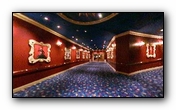 After creating permanent installations in Las Vegas and Orlando, in 1999 Cirque du
Soleil moved into another new home, this time at the $685 Million (USD) Beau Rivage
resort in Biloxi, MS. The 1,560-seat theatre opened on May 20, with the touring
production of Alegria settling in for what was to be a long run at the end of its
five-year international tour.
After creating permanent installations in Las Vegas and Orlando, in 1999 Cirque du
Soleil moved into another new home, this time at the $685 Million (USD) Beau Rivage
resort in Biloxi, MS. The 1,560-seat theatre opened on May 20, with the touring
production of Alegria settling in for what was to be a long run at the end of its
five-year international tour.
The initial design concept for the 52,000-sq.-ft. theatre came from
Michel Crete, who also designed the sets for Alegria, and for most of Cirque
du Soleil's other productions. The design was realized by an architectural
and theatre consultant team including Michel Aube, Patrick Berger, and Claude
Andre Roy from Sceno Plus, a Montreal-based firm that has worked with Cirque
du Soleil on its other permanent installations as well.
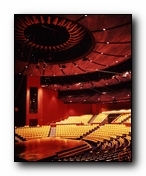 For those who bore its splendor, the design of the venue was simple
and elegant, featuring a wonderful splash of color. And, unlike the
"O" theater the Alegría Theater was ornamented with an elegant display
of the show's name - right above the door. Inspired by the warm climate of
the South of France and the paintings of Henri Matisse, the theatre had a
bright yellow ceiling medallion to recall the sun, a blue ceiling which
recalled a big top for the sky, red and orange sunset tones on the walls,
sandy yellow seats to envoke the beaches, and Matisse-blue carpeting.
The warm ambiance of the room was at home in its location on the Gulf of
Mexico. Sky Art also provided designs for a 15,000 square-foot mural
reminiscent of Claude Montet's water paintings. "The ceiling is not just
blue," says Aube, "but a voluptuous melange. The theatre is a happy marriage
of colors."
For those who bore its splendor, the design of the venue was simple
and elegant, featuring a wonderful splash of color. And, unlike the
"O" theater the Alegría Theater was ornamented with an elegant display
of the show's name - right above the door. Inspired by the warm climate of
the South of France and the paintings of Henri Matisse, the theatre had a
bright yellow ceiling medallion to recall the sun, a blue ceiling which
recalled a big top for the sky, red and orange sunset tones on the walls,
sandy yellow seats to envoke the beaches, and Matisse-blue carpeting.
The warm ambiance of the room was at home in its location on the Gulf of
Mexico. Sky Art also provided designs for a 15,000 square-foot mural
reminiscent of Claude Montet's water paintings. "The ceiling is not just
blue," says Aube, "but a voluptuous melange. The theatre is a happy marriage
of colors."
The stage and audience areas are the same size as those in the Cirque's touring
big top, since this theatre was to be used for various shows as they completed
their tours. Designed with the tent in mind, the seating wraped 270 degrees, or almost
all the way around the 3/4 thrust stage. It had no obstructive poles, providing a
limitless viewpoint to all spectators. The set and stage retained its familiar
squarish form, complete with the Fast Track built into the floor. Overhead an
enormous dome that for designer Michel Crête signifies "a sign of
imposing power," which reflects the theme of the show - an allegory
about power; who has it and who does not. The space had two
grids to allow an eventual conversion to a proscenium theatre if desired in the
future. A lighting ring hung 10' under the lower grid and over the stage, with a series
of moving rays or fingers that create a full circle, which closes to hide the grid. The
structure was usually left open for performances, but it could be closed if a more
traditional production ever moved into the space.
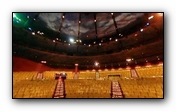
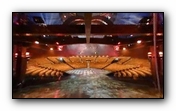
"The largest challenge in designing this theatre," says Aube, "was to integrate
a touring show into a permanent space and keep the sense of intimacy. It had to be
a flexible room yet a warm, interesting space for Cirque." One of the attempts to
add intimacy to the room is the 39" span from one chair arm to the next, while
this distance measures 42" at both the Mystere and O theatres in Las Vegas.
The lighting system included 900 ETC Sensor dimmers (10 racks of 90) and two
Strand 550i consoles. "We are the only Cirque show to run everything with one board,"
says Alegria's lighting director John Farber, who explains that the second console
serves as a backup. The lighting for the show was designed by Luc Lafortune, whose
rig includes 425 ETC Source Four ellipsoidals, 80 Wybron Coloram II scrollers, and
10 Clay Paky Stage Zoom automated luminaires. An ethernet hub system was installed
by Production Arts/PRG.
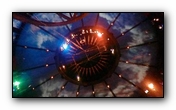
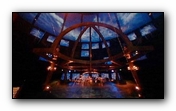
When Alegria came in from the road, the challenge for sound designer Guy Desrochers
was to use the touring sound system in the theatre. The system includes a Midas XL3
console, 67 JBL 4892 and 4893 speakers, 45 JBL amplifiers (MPA600s and 1100s), JBL
DSC 260 & 280 processing, and 10 Klark Teknik DN3600 graphic equalizers. "I spent
three and a half months on the road with the show," says audio engineer Jason
Pritchard, who runs the show. "This room sounds amazing compared to the tent, which
is a very difficult environment for sound. Guy did an amazing job redoing the road
system for the theatre. There is even coverage for every single seat."
The total cost for the theatre was $19.4 million, with $4 million dedicated to
technical equipment.
On October 2, 2000, Alegría packed up its troubles and prepared for a
journey to a continent it had never before played - Australia. Today,
the "Beau Rivage Theater" has been completely renovated for more
standard fare - such as Lord of the Dance and STOMP.
|

![]()




